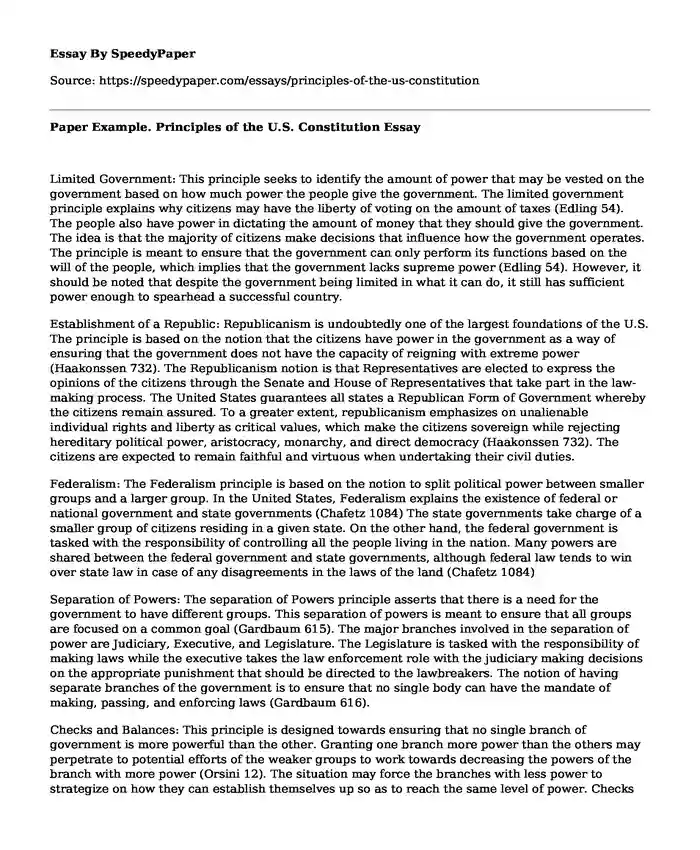
| Type of paper: | Essay |
| Categories: | United States Democracy Constitution |
| Pages: | 3 |
| Wordcount: | 739 words |
Limited Government: This principle seeks to identify the amount of power that may be vested on the government based on how much power the people give the government. The limited government principle explains why citizens may have the liberty of voting on the amount of taxes (Edling 54). The people also have power in dictating the amount of money that they should give the government. The idea is that the majority of citizens make decisions that influence how the government operates. The principle is meant to ensure that the government can only perform its functions based on the will of the people, which implies that the government lacks supreme power (Edling 54). However, it should be noted that despite the government being limited in what it can do, it still has sufficient power enough to spearhead a successful country.
Establishment of a Republic: Republicanism is undoubtedly one of the largest foundations of the U.S. The principle is based on the notion that the citizens have power in the government as a way of ensuring that the government does not have the capacity of reigning with extreme power (Haakonssen 732). The Republicanism notion is that Representatives are elected to express the opinions of the citizens through the Senate and House of Representatives that take part in the law-making process. The United States guarantees all states a Republican Form of Government whereby the citizens remain assured. To a greater extent, republicanism emphasizes on unalienable individual rights and liberty as critical values, which make the citizens sovereign while rejecting hereditary political power, aristocracy, monarchy, and direct democracy (Haakonssen 732). The citizens are expected to remain faithful and virtuous when undertaking their civil duties.
Federalism: The Federalism principle is based on the notion to split political power between smaller groups and a larger group. In the United States, Federalism explains the existence of federal or national government and state governments (Chafetz 1084) The state governments take charge of a smaller group of citizens residing in a given state. On the other hand, the federal government is tasked with the responsibility of controlling all the people living in the nation. Many powers are shared between the federal government and state governments, although federal law tends to win over state law in case of any disagreements in the laws of the land (Chafetz 1084)
Separation of Powers: The separation of Powers principle asserts that there is a need for the government to have different groups. This separation of powers is meant to ensure that all groups are focused on a common goal (Gardbaum 615). The major branches involved in the separation of power are Judiciary, Executive, and Legislature. The Legislature is tasked with the responsibility of making laws while the executive takes the law enforcement role with the judiciary making decisions on the appropriate punishment that should be directed to the lawbreakers. The notion of having separate branches of the government is to ensure that no single body can have the mandate of making, passing, and enforcing laws (Gardbaum 616).
Checks and Balances: This principle is designed towards ensuring that no single branch of government is more powerful than the other. Granting one branch more power than the others may perpetrate to potential efforts of the weaker groups to work towards decreasing the powers of the branch with more power (Orsini 12). The situation may force the branches with less power to strategize on how they can establish themselves up so as to reach the same level of power. Checks and balances ensure that the three branches of the government have the capacity of checking on the powers exercised by each group, which means ideas portrayed by a given branch may be disapproved or stopped by the other. In the United States, checks and balances are portrayed in the ability of the President to veto a given bill as long as other government branches have passed it. Overriding a veto requires a super-majority (Orsini 15).
Works Cited
Chafetz, Josh. "Multiplicity in Federalism and the Separation of Powers." (2010): 1084.
Edling, Max M. A Revolution in Favor of Government: Origins of the US Constitution and the Making of the American State. Oxford University Press, 2003.
Gardbaum, Stephen. "Separation of powers and the growth of judicial review in established democracies (or why has the model of legislative supremacy mostly been withdrawn from sale?)." The American Journal of Comparative Law 62.3 (2014): 613-640.
Haakonssen, Knud. "Republicanism." A Companion to Contemporary Political Philosophy (2017): 729-735.
Orsini, Becky, and Nick Thomason. "What Constitutes a Constitution?" (2011).
Cite this page
Paper Example. Principles of the U.S. Constitution. (2023, Apr 03). Retrieved from https://speedypaper.com/essays/principles-of-the-us-constitution
Request Removal
If you are the original author of this essay and no longer wish to have it published on the SpeedyPaper website, please click below to request its removal:
- Free Essay with Knowledge on How to Start Writing
- Book Review in the Free Essay - Flapper by Joshua Zeitz
- Essay Sample: Reasearch on Education Needed to Be a Nurse
- Education Essay Example: Curriculum Implementation
- The Feast at Lele - A Cultural Event Essay Sample
- Research Paper Example about Haitian Vodou
- Free Essay Example on Improving Healthcare for the Elderly
Popular categories




